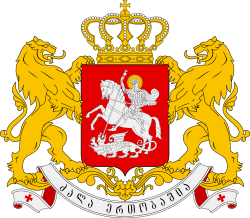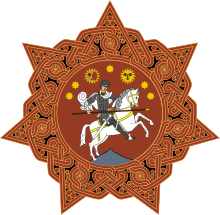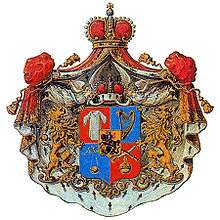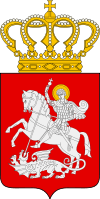Coat of arms of Georgia (country)
| Coat of arms of Georgia | |
|---|---|
 | |
| Versions | |
|
Lesser | |
| Details | |
| Armiger | Republic of Georgia |
| Adopted | 1 October 2004 (latest rendition) |
| Crest | Royal crown of Georgia Or |
| Escutcheon | Gules, with an image of Saint George, riding a horse trampling upon a crawling dragon, whose head is pierced by the saint's spear, all of them Argent |
| Supporters | two lions rampant Or |
| Compartment | A decoration Or |
| Motto |
ძალა ერთობაშია Dzala Ertobashia "Strength in Unity" |
The coat of arms of Georgia is one of the national symbols of the republic. It is partially based on the medieval arms of the Georgian royal house and features Saint George, the traditional patron saint of Georgia. In addition to St. George, the original proposal included additional heraldic elements found on the royal seal, such as the seamless robe of Jesus, but this was deemed excessively religious and was not incorporated into the final version.[1]
Blazon
Gules, with an image of Saint George, riding a horse trampling upon a crawling dragon, whose head is pierced by the saint's spear, all of them Argent. It has two lions rampant as supporters of the shield, which is surmounted with the royal crown of Georgia, all of them Or. The motto below the shield reads as : "Strength is in Unity" (Dzala Ertobashia, written in the Mkhedruli script of the Georgian alphabet, ძალა ერთობაშია).
Former coats of arms
- 1918-1921 and 1991-2004:
This coat of arms was in use by the Democratic Republic of Georgia throughout its existence in 1918-1921. Though the use of Saint George as Georgia's patron saint was by then a long tradition, there were some discussions about other possibilities, the major one being Amiran, as the symbol of Georgia's fight for freedom from the Russian Empire. However, a decision was then made in favor of Saint George. Restored in 1991, this coat of arms was replaced by the current one in 2004.
- 1801-1917:
Before 1917, when Georgia was part of the Russian Empire, the Georgian coat of arms appeared on the Greater Coat of Arms of the Russian Empire, as part of the coat of arms of Caucasus. It showed then as the center inescutcheon, and read as follows:
Or, with an image of Saint George Martyr the Victorious in complete armour Azur with a cross on his breast, with a flying cloak Gules, riding a horse Sable in full gallop, the latter covered with a horse cloth Gules, fringed Or, trampling upon a crawling dragon Vert, winged Sable, eyed and tongued Gules, whose head is pierced by the saint's spear Gules.
- Before 1801:
Coats of arms were mostly those of the Bagrationi, who claimed to have King David among their ancestors, and included such elements as King David's lyra and sling, or the Holy Tunic.
-

The emblem used by both the Democratic Republic of Georgia between 1918 and 1921 and Georgia since its independence from the USSR until 2004
-

Great coat of arms of the Georgian royal house
-
An 1807 metalwork of the Georgian royal coat of arms
-

Coat of arms design used by the First Republic (1918-1921), as well as post-communist Georgia (1991-2004)
-
.svg.png)
Coat of Arms of the Transcaucasian Socialist Federative Soviet Republic (1922-1924)
-
.svg.png)
Coat of Arms of the Transcaucasian Socialist Federative Soviet Republic (1924-1930)
-
.svg.png)
Coat of Arms of the Transcaucasian Socialist Federative Soviet Republic (1930-1936)
-

Coat of Arms of the Georgian Soviet Socialist Republic
-

The lost crown of King George XII, painted by Fedor Solntsev from the Kremlin Museum
See also
References
- ↑ საქართველოს პარლამენტი, "საქართველოს პარლამენტის განათლების, მეცნიერების, კულტურისა და სპორტის კომიტეტის გასვლითი სხდომის ოქმი #14", მაისი-ოქტომბერი 2004
External links
| Wikimedia Commons has media related to Coats of arms of Georgia. |
- President of Georgia website
- The Georgian Coat of Arms in: Georgian History by Giorgi Gabeskiria.



